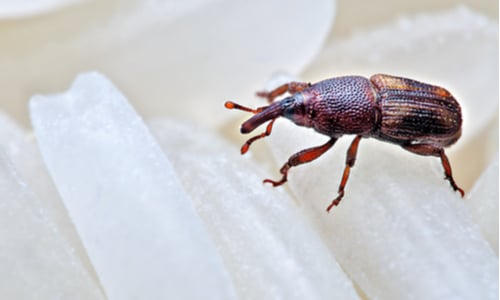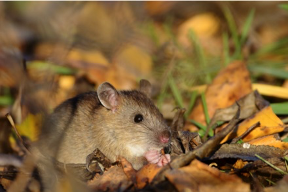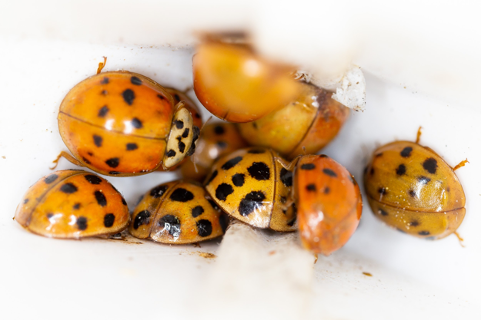Stored product pests are a group of small, bothersome moths and beetles frequently found in cupboards and pantries. They feast upon grains, cereals, dried fruit, nuts, pet food and birdseed. By storing food properly and noticing signs of infestation, you can prevent these invaders from taking over your home.
Most stored product pests live short lives, but they breed quickly. They contaminate food by laying their eggs in it. Some adult females lay up to 1,000 eggs during their lives. If you notice small moths or beetles on your walls or ceilings, worm-like larvae in your dry foods or shed skins in cupboards and pantries, you may have a stored product pest problem – which is not easy to say five times fast! But we can help you fix it.
Types of Stored Product Pests
Stored product pests are small, persistent and sometimes difficult to spot because the larvae often mature inside your food. Prevent discovering this the hard way by understanding some of the common species and their behaviors.
● Indian Meal Moths are among the more common stored product pests. They are small ¼ inch beige and copper colored moths that are most active at night. During the days they can be seen motionless on walls or ceilings, usually in kitchens or pantries where food is stored. Adult Indian meal moths don’t eat your food, but their larvae do. The larvae are small off-white to pink worms that sometimes leave a silky webbing behind. Because they fly and because they pupate away from their food source, Indian meal moths can be difficult to eliminate.
● Rice Weevils are small –¼ inch reddish brown bugs. They have a long snout and pale spots on their wings. Adult rice weevils can fly and live 6-8 moths. They seek out food with a hard coat such as rice, corn, barley, peas and birdseed to lay their eggs in. The legless grubs develop unseen inside kernels of food and live off the nutrients until they emerge full grown.
● Sawtooth grain beetles are brown, tiny 1/16-1/8inch beetles named for the toothy ridge along their thorax just below their neck. Because of their small size and flat shape, sawtooth grain beetles can crawl through small cracks and get into food containers that aren’t airtight. They live an average of 6-8 months but have been known to last years. They pose a recurring threat if not properly dealt with.
● Red Flour beetles are another type of tiny beetle. They are long, flat and dark cherry or dark brown in color. They have club shaped antennae and wings capable of flight. They are a common form of pest, especially in food processing plants and storage warehouses. Adult females will lay upwards of 1,000 eggs during their lifetime so stopping infestation early is key.
● Warehouse or carpet beetles are dark oblong or oval shaped beetles. The larvae are reddish in color and recognizable by their long thin tufts of hair. These types of beetles can diapause or shut down when food is scarce and reactivate once food is available. This combined with their ability to chew through food packaging make them a persistent nuisance.
What are the Risks of Stored Product Pests?
The biggest risk of stored product pests is the destruction of your food. Small beetles and moths can do a surprisingly large amount of damage if they go unnoticed. Given time to mate and lay eggs, a few beetles can quickly turn into a full infestation.
While stored product pests don’t bite and aren’t known for transmitting diseases or other health risks, they will spoil your food and use it as a breeding ground. Pretty gross, we know. If you find food that has been contaminated, throw it away and vacuum the cupboard or shelf thoroughly. Lingering grain kernels can invite another round of pests. Shake food containers and packages to find existing pests - they may be burrowing inside and will appear when jostled.
How to Prevent Stored Product Pests in Your Home
Prevention means keeping your food safely stored and your shelves and cupboards clean. Transfer packaged grains and cereals to airtight jars and containers. Pet food and birdseed are often overlooked sources of stored product pests so don’t forget to properly store them.
Rotate food and don’t leave old packages or expired food in the back of your cupboard. Unchecked foods like rice, flour, beans and dried fruit can become breeding grounds for pests.
Clean out and sanitize your pantry and shelves periodically. A clean pantry reduces your risk of infestation.
How to Get Rid of Stored Product Pests
There are traps you can use to kill and eliminate pests in your home. Traps are baited with an attractant and covered with a sticky surface that pests cannot escape from. The nice thing about sticky traps is that they allow you to identify the type of pest(s) you have. Rotate out used traps frequently so future visitors aren’t discouraged from taking the bait.
Get Reliable Professional Help with Stored Product Pests
Did you find a moth in your meal? A beetle in your beans? It can be surprising and discouraging to find pests in your food supply. We’ve been helping families feel safe from all manner of pests for over 100 years. Contact Plunkett’s today and let us make sure stored product pests are never invited back into your cupboards.









